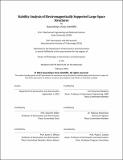Stability analysis of electromagnetically supported large space structures
Author(s)
Gettliffe, Gwendolyn Vines
DownloadFull printable version (14.76Mb)
Other Contributors
Massachusetts Institute of Technology. Department of Aeronautics and Astronautics.
Advisor
David W. Miller.
Terms of use
Metadata
Show full item recordAbstract
The high cost per unit mass of launch and the fixed envelope of a launch vehicle fairing respectively incentivize the reduction of spacecraft mass and stowed volume, while the performance boosts that come from an increase in spacecraft dimensions incentivize the maximization of spacecraft deployed size. Also, specific missions might benefit from a particular capability that represents a prohibitive addition of mass to the system or which may be performed inefficiently with current technology, and some missions cannot be accomplished without a capability that existing technologies cannot provide. New technologies, especially those that can contribute multiple capabilities that span the purviews of multiple subsystems, have the potential to enhance or even enable certain mission concepts. This thesis introduces the concept of an electromagnetic subsystem which can provide both structural and ancillary capabilities to a large spacecraft, due to the tendency of two powered coils to exert forces and torques on one another, as well as several missions that would benefit from such a subsystem and in the process help to mature the technology. As with any new technology, risks and challenges are identified as well as other enabling technologies which must be developed in parallel to make an electromagnetic subsystem possible. One major risk comes from the fact that the only stable configuration of two magnets is collocated and attracting at the origin. In repulsion, magnets are fundamentally unstable because they either diverge or rotate such that they attract and converge to the origin. Elastic hardware is added to the system to provide restorative forces and torques, but instability of the system remains a concern. In this work, a validated methodology is developed for identifying pseudo-passive equilibria and classifying them as statically and dynamically stable or unstable and is applied to a series of electromagnetic structures of increasing realism and degrees of freedom to show that stable configurations can exist with appropriate boundary conditions. The methodology is later applied to a variety of systems, including a larger structure with more coils and connective hardware with different properties, to observe how stability conditions change with changes in assumptions or system size.
Description
Thesis: Ph. D., Massachusetts Institute of Technology, Department of Aeronautics and Astronautics, February 2016. This electronic version was submitted by the student author. The certified thesis is available in the Institute Archives and Special Collections. Cataloged from student-submitted PDF version of thesis. Includes bibliographical references (pages 246-250).
Date issued
2016Department
Massachusetts Institute of Technology. Department of Aeronautics and AstronauticsPublisher
Massachusetts Institute of Technology
Keywords
Aeronautics and Astronautics.